Climate change has led to a rise in temperature and humidity, but the growing urban sprawl has also played a role in heating up Indian cities, which has resulted in the “urban heat island effect”.
Intensifying Heat Waves in Indian Cities
- Report by the Centre for Science and Environment: The extreme summer months in Indian cities over the last two decades is due to rising temperature, relative humidity, a rapid increase in built-up areas and concretisation and changes in land use.
- Consecutive Hot Year: This is the third straight year of severe heat waves in India, which have been far longer, over 10 days-long — this time than the usual four to eight days.
- Study by the United Kingdom’s Met Office: An earlier assessment said that the spell of record-breaking temperatures in India may occur every three years now instead of the previous time frame of about 300 years.
Enroll now for UPSC Online Course
About Urban Heat Island Effect
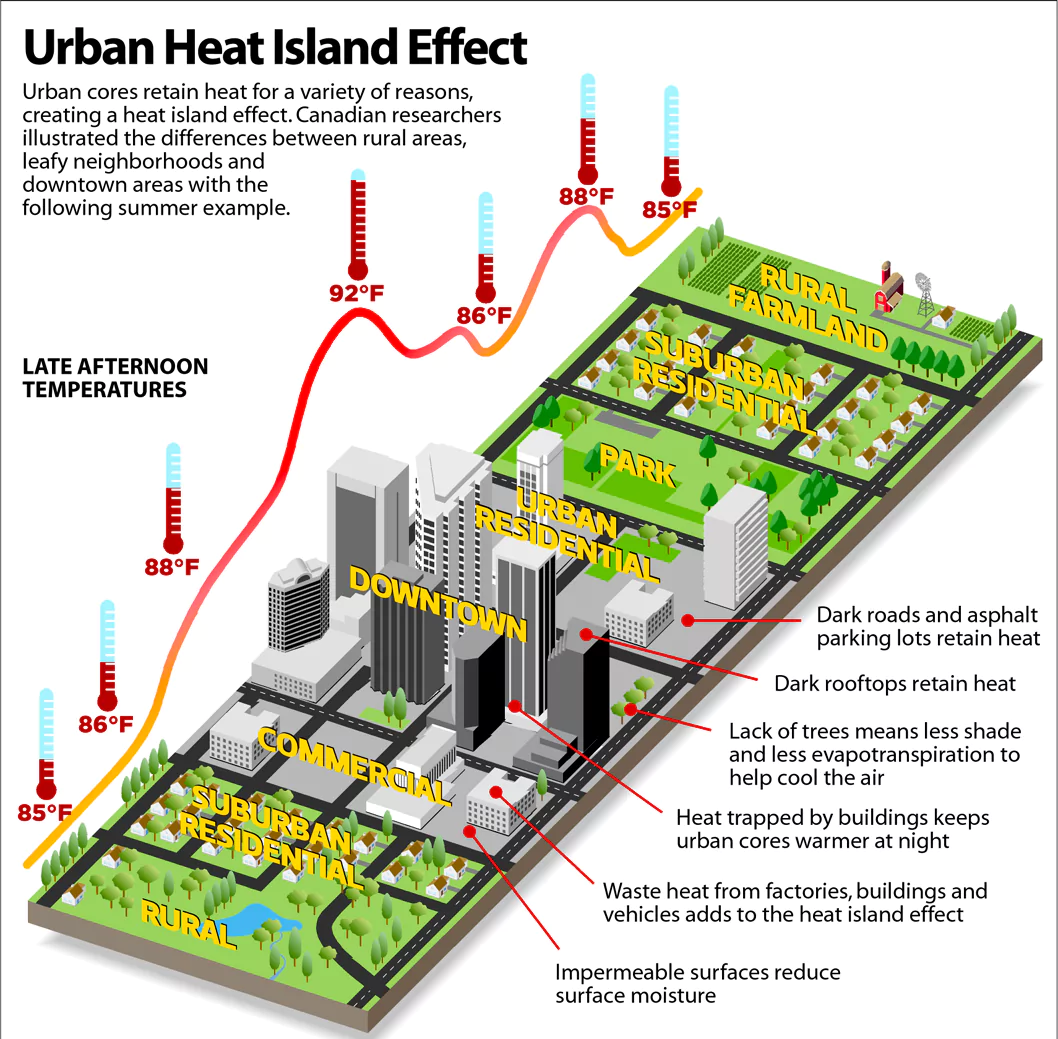
- Refers: It occurs when urban areas witness higher temperatures than their rural surroundings.
- Occurrence: Urban heat islands result from complex interactions between built environments, natural factors, and human activities.
- This is mostly due to human activities, buildings and infrastructure in cities that absorb and retain heat more effectively than natural landscapes.
Causes of Urban Heat Island
- Use of Heat Absorbing Materials: Materials such as concrete and asphalt in urban areas absorb heat during the day and release it slowly, causing temperatures to remain elevated, especially at night.
- Buildings with dark surfaces reduce the albedo and increase heat absorption.
- Inappropriate Construction: When buildings are built adjacent to each other, it limits airflow and creates heat-trapping spaces between structures, causing higher temperatures.
- Absence of Greenery: The absence of plants, trees, and green spaces in cities reduces natural cooling through shade, worsening the heat island effect.
- Less Tree Cover: The lack of trees increases the risk of exposure to higher temperatures. In Indian cities, there are places with such poor density of trees as one tree for 50 people.
- There are some places where it could be as low as one tree for 450 people. All these contribute to worsening the urban heat islands effect.
- According to a 2014 Indian Institute of Science report, the ideal tree-human ratio should be seven trees for every person.
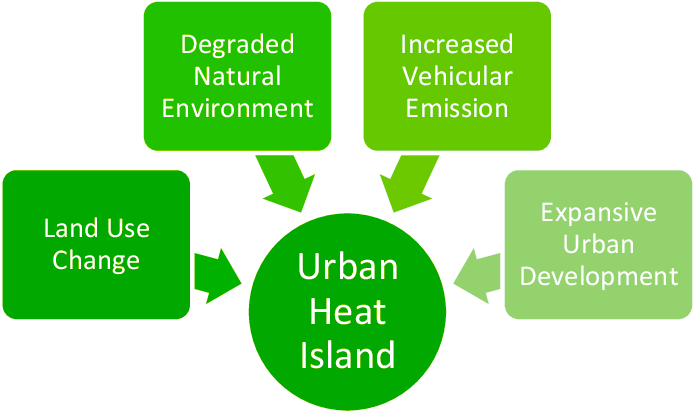 High Energy Demands: Metropolitan cities have higher energy demands for things like transportation, industrial processes, and air conditioning, which release heat into the air, contributing to the urban heat island effect.
High Energy Demands: Metropolitan cities have higher energy demands for things like transportation, industrial processes, and air conditioning, which release heat into the air, contributing to the urban heat island effect. -
- The air conditioners emit hot air which further causes more heat thereby having a cascading effect.
- Transportation systems produce a great amount of heat due to burning of fossil fuel which is beyond the carrying capacities of incoming cool winds.
- Presence of Pollution: Urban heat islands have poorer air quality because more pollutants get trapped in the city. Warm water from cities also harms the quality of nearby streams, affecting the plants and animals living there.
Effects of Urban Heat Island
- Health Hazards: This is a serious cause for concern as the heat stress continues to build, increasing the risk of heat-related illnesses and even death.
- It poses a grave risk to lives, especially among vulnerable groups like the elderly, babies, pregnant women, those who live in slums and work outdoors.
- Environmental Hazards: Urban heat islands may contribute to global warming by increasing overall temperatures in urban areas and beyond.
- They lead to lower air quality due to more pollution as a result of increased fossil fuel consumption and the pollution in the region makes water bodies polluted.
- One alarming consequence of this is that summer nights now offer little respite from the searing heat of the day, with cities across climatic zones not cooling down at the rate they once did.
- Urban heat islands could lead to temperature differences of up to six degrees centigrade within a given area or neighbourhood.
- This could change depending on the construction material used, the number of buildings around the area and the way it is built, the road materials that have been used and tree/green cover presence and density in the particular locality.
- Also the lack of water bodies can add to the heat effect.
- Power Outages & Increase in Energy Cost: All this also puts a strain on energy sources, leading to increase in energy costs and power outages when demand peaks.
- As per study of the Resources for the Future, each 1°C increase in temperature raises energy demand by 0.5% to 5%, depending on the local level of air conditioning penetration.
Challenges that India Needs to Address
- Lacking Behind in Tech Adoption: India’s tech adoption in weather and heat risk monitoring is improving but may not be at par with other developed countries that have sophisticated systems due to more resources allowing them to deploy more extensive networks and achieve higher-resolution data.
- Example: While leading Indian cities have seven to eight India Meteorological Development weather stations on an average, a comparable city like San Francisco would have more than 100 weather monitoring stations.
- Less Available Data: India’s focus on weather has been more on water risk and security and hence have more granular data on precipitation, while heat is not a consistent part of the monitoring process.
- In developed economies, weather tracking is done by a variety of actors, from academic and research institutions to government bodies to the private sector. All of this rich data provides a much more nuanced understanding of scenarios.
- Negligence in Enforcement: While more than 20 states have worked with the NDMA to create Heat Action Plans (HAP), most remain on paper. They are hampered by a lack of funding, granularity and a sustainable vision for transformation.
Enroll now for UPSC Online Classes
Are Heat Islands the same as Climate Change?
- Heat islands and climate change are not the same, but they are related.
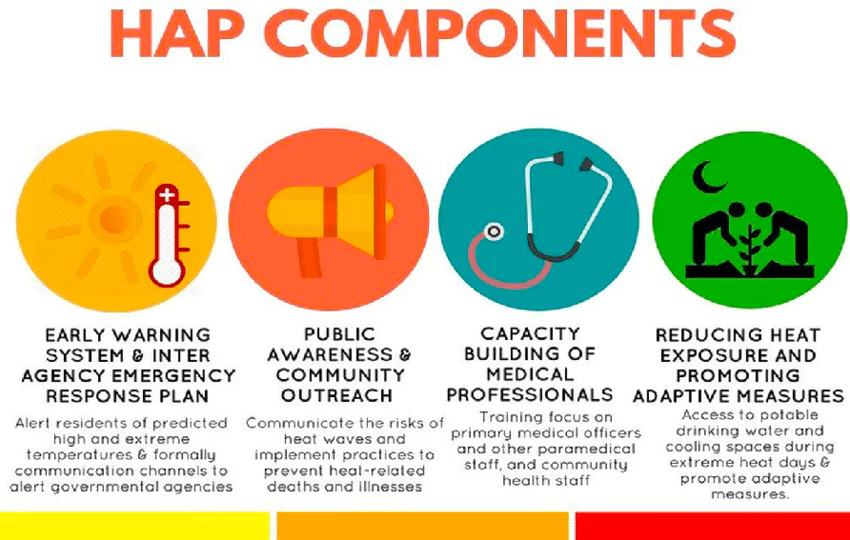 Differences: Heat islands happen when cities are hotter than their surroundings, whereas, climate change is the long-term warming of the Earth due to gases in the air trapping heat. Differences: Heat islands happen when cities are hotter than their surroundings, whereas, climate change is the long-term warming of the Earth due to gases in the air trapping heat. -
- While heat islands don’t directly cause climate change, they make cities hotter, which can make climate change effects worse.
- Concern: Cities are getting hotter because of both heat islands and climate change.
- As more people live in cities, the problem of heat islands gets bigger. This means cities will face even more heatwaves in the future.
- So, while heat islands don’t cause climate change, they make it worse for people living in cities.
Case Study of Ahmedabad:
- A Success Story: If there is a success story in heat tracking by an Indian city, it is certainly Ahmedabad, which turned a new leaf after the heatwave of 2010 which led to deaths of more than 2,000 people.
- Heat Action Plan: In 2012, Ahmedabad developed a heat action plan.
- This initiative included the deployment of temporary monitoring stations, satellite-based heat maps and early warning systems to identify areas vulnerable to extreme heat events.
- The data collected from these systems is helping inform decision-making and design interventions to mitigate the heat stress.
Present Scenario in India:
- Now all over India, more than 24 cities and states are in the process of preparing ‘heat action’ plans demonstrating the value of using technology-driven evidence and decision-support systems to tackle urban heat issues.
- The tech for mitigation is around building materials like cool roofing materials, reflective building materials, different varieties of paints, apart from having vertical gardens, urban forests and green infrastructure. There is work going on in several cities of Gujarat on this issue.
|
Way Forward
- Sustainable Management: The urban heat islands issue is an urban design and development issue, which needs to be looked at from a bigger lens of economic policy, city management and sustainable living in cities.
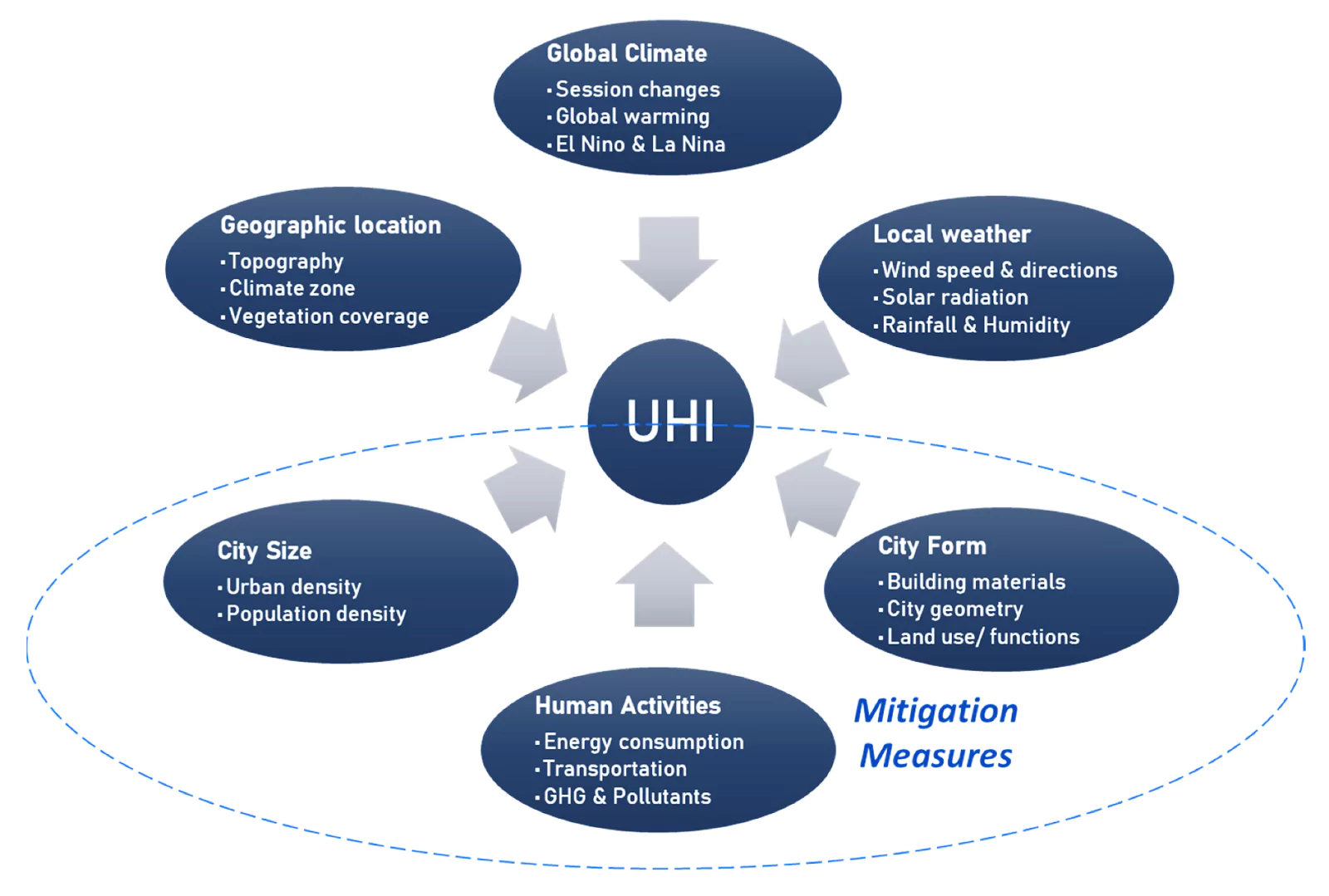 There is a growing consensus among experts that city-specific management plans (Heat Action Plan), which take into account local factors, are a far more effective response to heat waves. Such plans should prioritise green spaces and water bodies and target all heat generators, including vehicles, industries and concrete surfaces.
There is a growing consensus among experts that city-specific management plans (Heat Action Plan), which take into account local factors, are a far more effective response to heat waves. Such plans should prioritise green spaces and water bodies and target all heat generators, including vehicles, industries and concrete surfaces.
- Example: Ahmedabad’s Cool Roofs programme, which offers an affordable solution for the urban heat island effect.
- There is a need to adhere to environmentally sustainable solutions like Green Building Code which makes the building more eco-friendly.
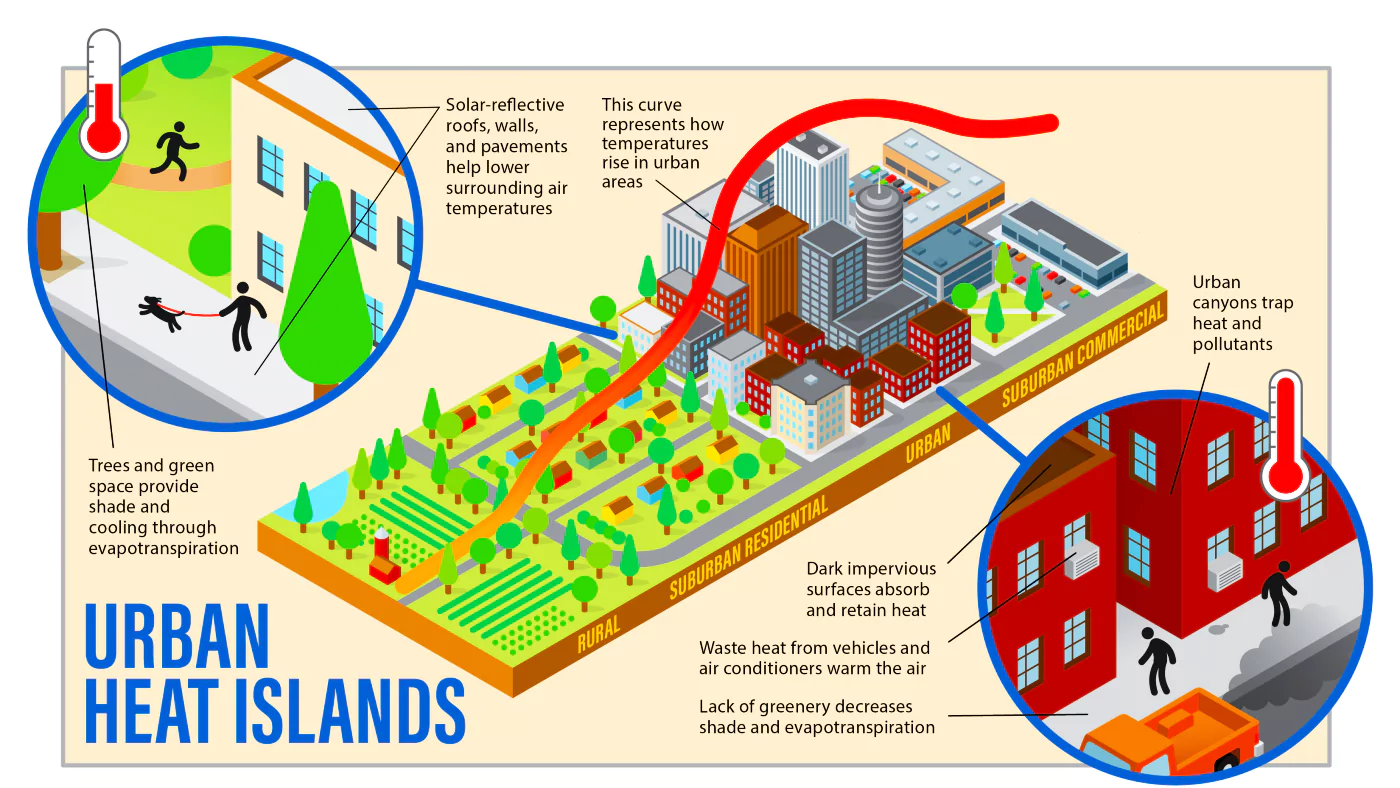 Adequate & Required Infrastructure:
Adequate & Required Infrastructure: -
- Build Green Roofs: These are an ideal heat island reduction strategy, providing both direct and ambient cooling effects. It also improves air quality by reducing the heat island effect and absorbing pollutants.
- Build Green Infrastructure: By planting trees and other vegetation to reduce the number of greenhouse gasses in the region and increase the evaporation and transpiration thus keeping the region cool. They also keep the surroundings cooler thereby decreasing the cost of air-conditioning.
- Light Colours of Buildings: It helps in less absorption of heat by increased albedo and less heat retention.
- Technological Advancements: In India, several tech innovations have enhanced weather and heat risk monitoring. And now, with AI, more advanced modelling techniques can be developed for weather forecasts which allow India to be prepared for heatwaves and other weather events.
- Example: Japan and China are looking at cool pavements, where they are looking at light coloured paints, special coatings etc. that reflect sunlight and can help lower surface temperatures and mitigate heat island effects. Such innovations are being studied in Pune and Delhi.
- Passive cooling technology is a widely-used strategy to create naturally ventilated buildings and can address the urban heat island issue.
- The IPCC report cites ancient Indian building designs that have used this technology, which could be adapted to modern facilities in the context of global warming.
- Innovations: There is also innovation of running cold water through pipes all across houses and many other architectural-led innovations for heat mitigation.
- India needs to incorporate heat-resilient designs based on factors such as building orientation, location, materials to maximise shade, create green spaces, and promote natural ventilation which all can help mitigate urban heat island effects.
- Focus on Individual Health Impact: The aspect of health tech is associated with heat stress, that is the provision of customised heat stress testing and customised alerts and medication based on vulnerabilities to heat or dehydration. This is not based on generalised guidelines but on customised individual data.
Enroll now for UPSC Online Classes
![]() 29 May 2024
29 May 2024
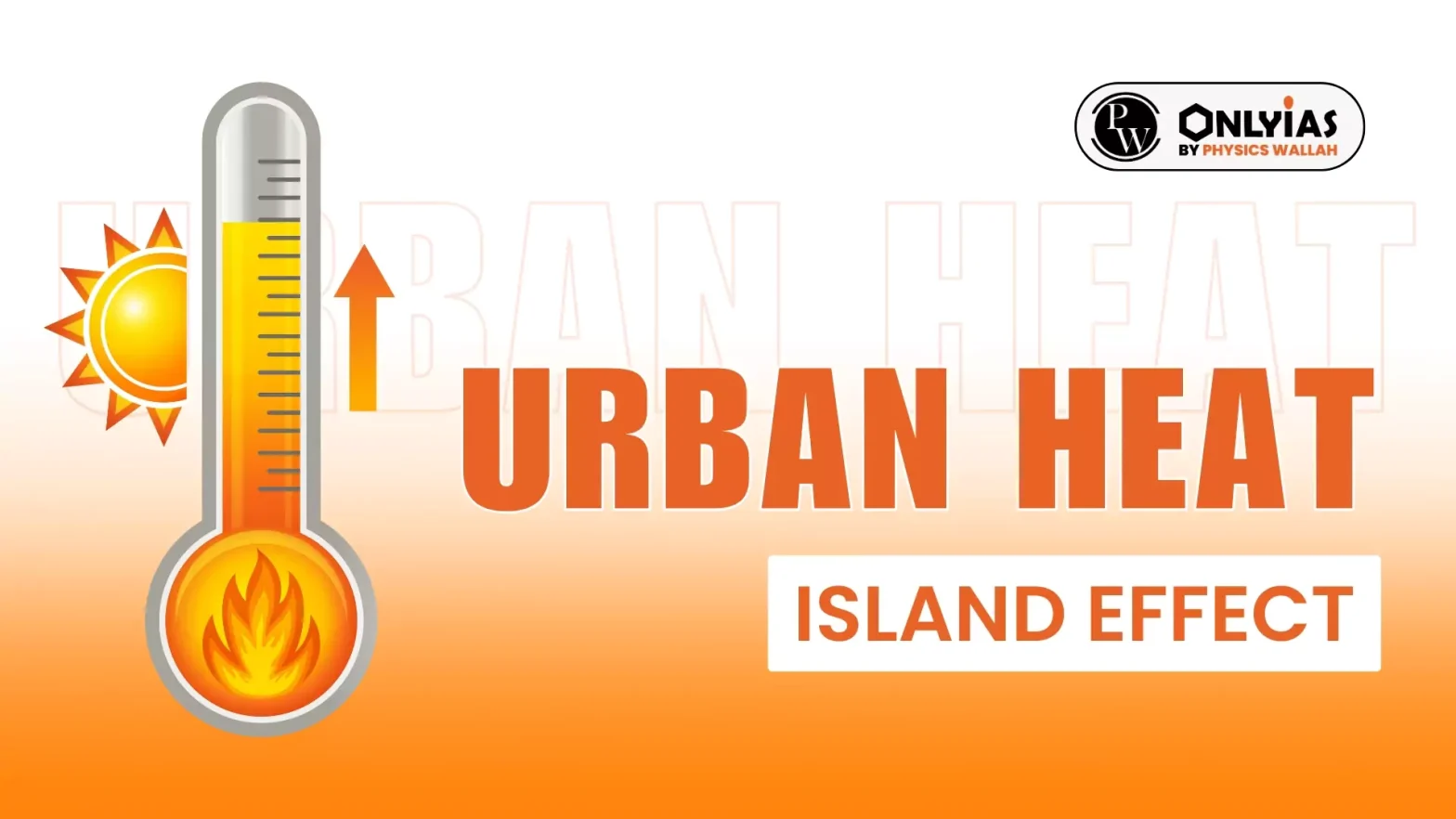

 High Energy Demands: Metropolitan cities have higher energy demands for things like transportation, industrial processes, and air conditioning, which release heat into the air, contributing to the urban heat island effect.
High Energy Demands: Metropolitan cities have higher energy demands for things like transportation, industrial processes, and air conditioning, which release heat into the air, contributing to the urban heat island effect.  There is a growing consensus among experts that city-specific management plans (Heat Action Plan), which take into account local factors, are a far more effective response to heat waves. Such plans should prioritise green spaces and water bodies and target all heat generators, including vehicles, industries and concrete surfaces.
There is a growing consensus among experts that city-specific management plans (Heat Action Plan), which take into account local factors, are a far more effective response to heat waves. Such plans should prioritise green spaces and water bodies and target all heat generators, including vehicles, industries and concrete surfaces.
 Adequate & Required Infrastructure:
Adequate & Required Infrastructure: 